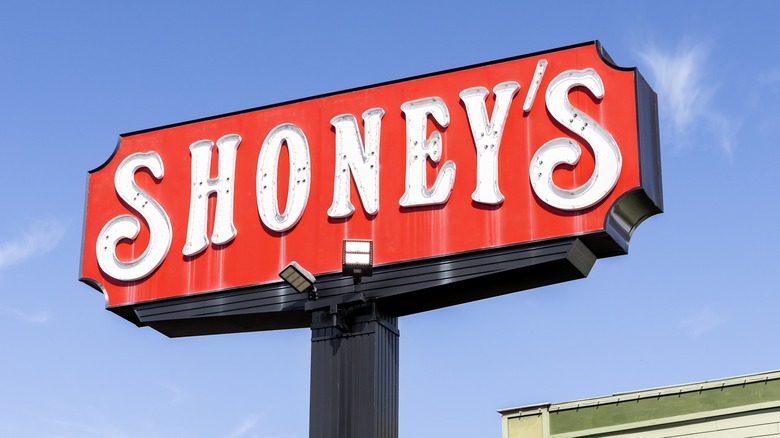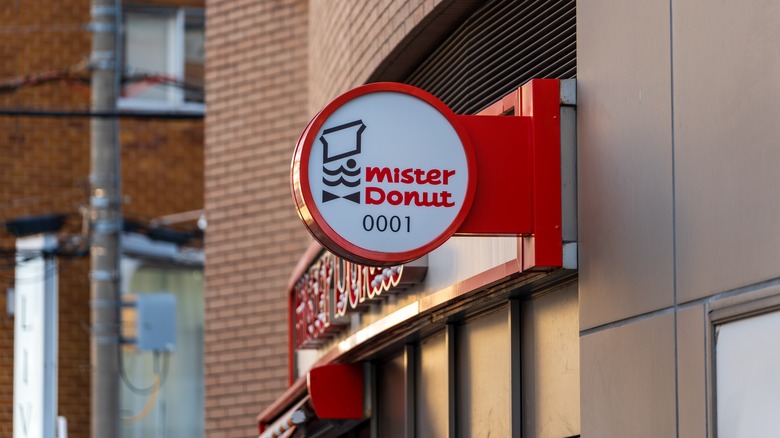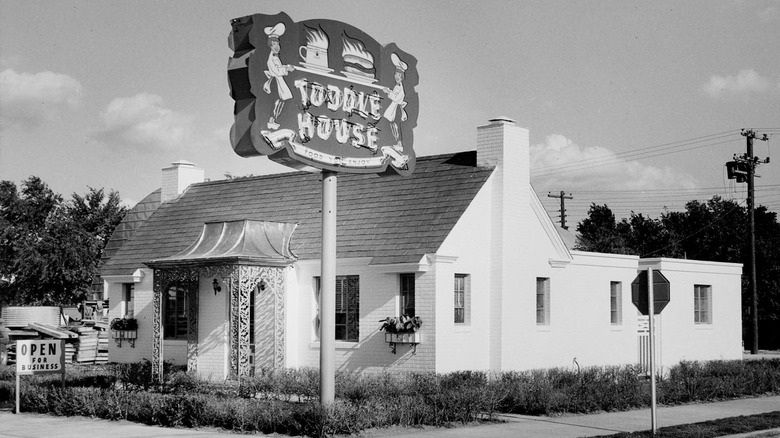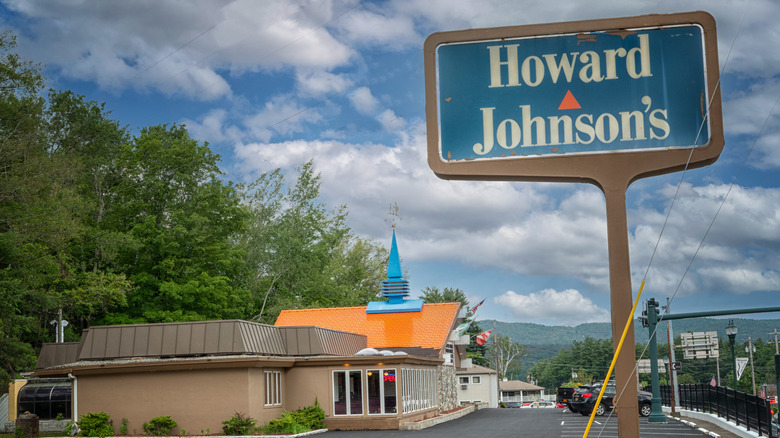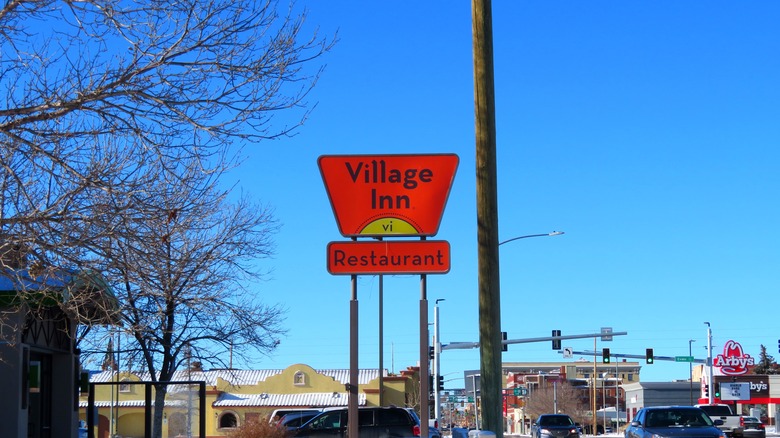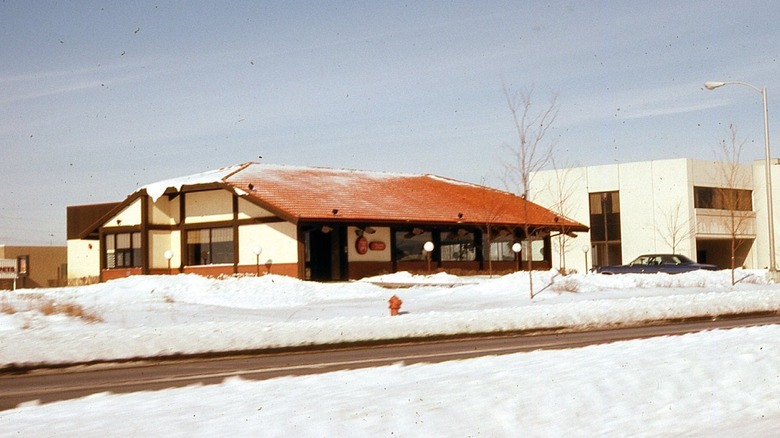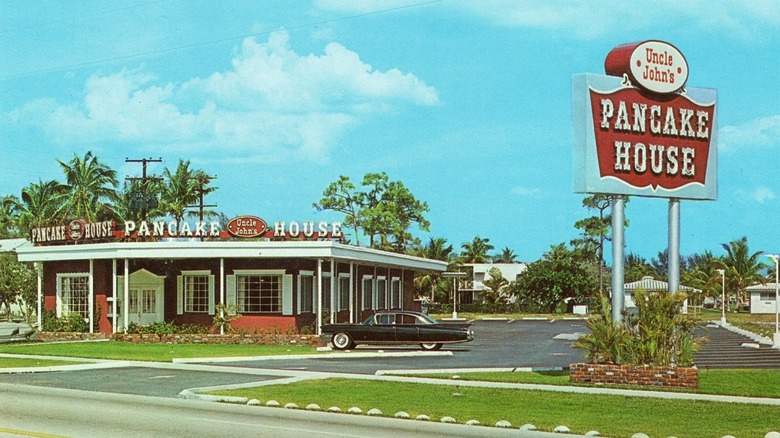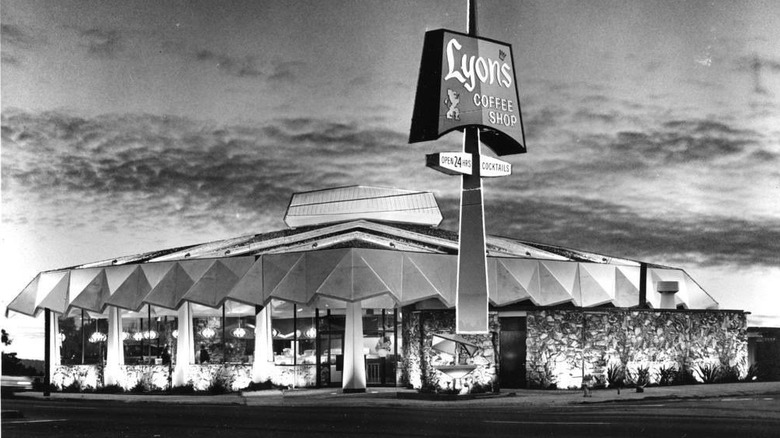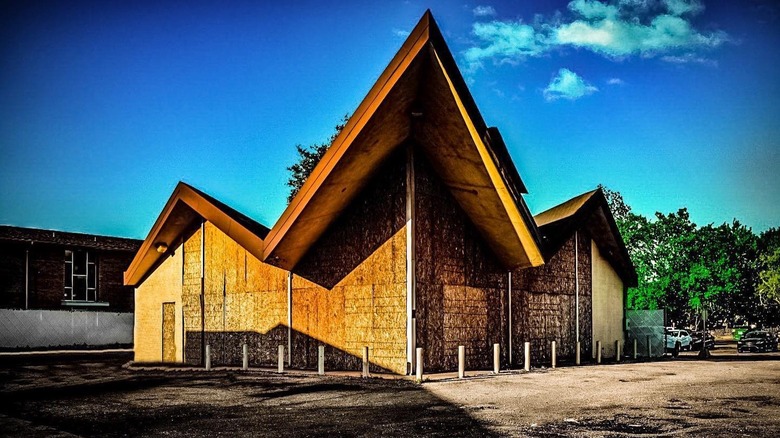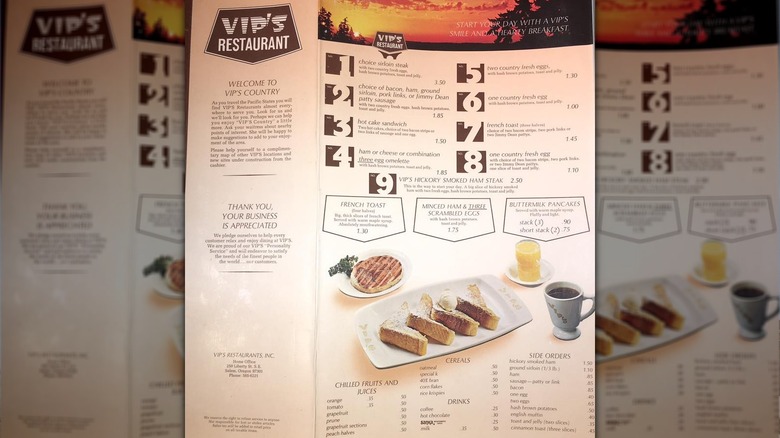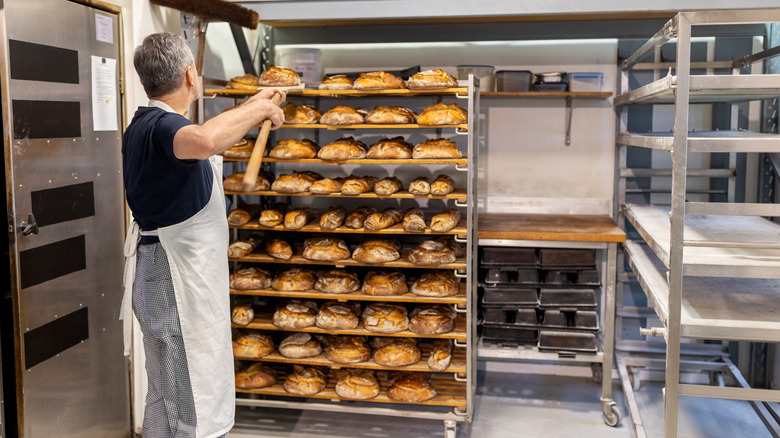Old-School Breakfast Chains That Have Disappeared Across America
Breakfast has undergone significant changes in the U.S. over the years. For many early settlers, the most important meal of the day often consisted of leftovers cooked in one pot for convenience, influenced by Native American dishes such as cornmeal mush. The arrival of the Battle Creek Toasted Corn Flake Company in 1906 — later known as Kellogg's — introduced people to an alternative grain-based breakfast option to start the day. But the all-American breakfast we know and love today is neither leftovers nor bland cereal. Instead, it consists of plates overflowing with waffles, pancakes drenched in maple syrup, eggs cooked to your liking, melt-in-your-mouth potatoes, and brimming carafes of coffee.
The likes of Denny's, Waffle House, and the Original Pancake House have long embodied the all-American breakfast, packaged and sold by well-financed advertising schemes. However, plenty of similar breakfast chains have fallen by the wayside over the years. There are numerous explanations as to why, including increased competition from independent breakfast joints and new chains, rising operational costs, and even shocking mismanagement. Here are some of the old-school breakfast chains that have disappeared across the U.S. — some completely, and others clinging on like burnt eggs in a pan.
Shoney's
Founded in Charleston, West Virginia, in 1947, Shoney's was initially called the Parkette Drive-In. Emerging from the post-war dining out boom, Shoney's was elevated by joining Big Boy restaurants in 1952, and offering the Big Boy, fast food's first double-decker burger. Separating from Big Boy in 1984, Shoney's went on to enjoy its heyday after introducing its popular all-you-can-eat breakfast bar, expanding into more than 1,300 locations in 34 states in the 1990s.
Unfortunately for Shoney's, expansion didn't necessarily equal domination. In 1993, Shoney's was involved in a class action lawsuit over allegations of racial discrimination within the business, which was later settled for over $130 million. Just after the decade came to a close, the company filed for Chapter 11 bankruptcy protection.
David Davoudpour, a major Church's Chicken franchisee, picked up the remaining 282 Shoney's restaurants in 2007. Despite the best efforts of the new owner to modernize the brand, Shoney's has gradually declined in numbers, with only 55 locations open and serving breakfast across 12 states.
Wag's
Walgreens entered the family-style restaurant scene with Wag's in 1975. The national pharmacy chain modeled the restaurant on old-school breakfast chains such as Denny's and Shoney's, offering affordable eats 24 hours a day. The first Wag's location opened in the Chicago area, selling breakfast classics like French toast, pancakes, and eggs, along with burgers and more for lunch and dinner, all available 24 hours a day. The popularity and proof of concept of the first restaurant led to more branches of the restaurant popping up around Chicago by the end of the 1970s, with the concept also proving popular in Florida.
Walgreens sold 91 Wag's restaurants to Marriott in 1988. Two years later, Marriott sold the 29 Wag's restaurants in Illinois to Lunan Family Restaurants, which converted them to Shoney's restaurants. The remaining restaurants in Florida were closed completely. Ultimately, Walgreens had a short foray into the world of breakfast that lasted just 16 years, and for some breakfast fanatics around Chicago, it was over far too soon.
Mister Donut
Families torn apart. Epic battles across the globe. While that may sound like the tagline from the summer's biggest blockbusters, it sums up the rivalry between Mister Donut and Dunkin' that spanned 36 years. It all started when William Rosenberg invited his brother-in-law, Harry Winokur, to join his growing doughnut shop, Dunkin'. The pair had a falling out over the direction of the business, and Winokur broke away to start Mister Donut in 1956 with a similar breakfast combo of coffee and donuts.
Mister Donut expanded to approximately 550 locations at its peak. The company's success ultimately led to its acquisition by Allied-Lyons — which, in another shocking twist to this tale, was the owner of Dunkin' at the time — in 1990. After the acquisition, the remaining Mister Donut franchises were encouraged to rebrand as Dunkin' locations.
Today, there is only one Mister Donut left in the U.S. in Godfrey, Illinois. However, there is a country with more than 1,000 locations and counting. Mister Donut may have lost the battle for the U.S., but the breakaway brand won the war in Japan, where it has become one of the most popular fast food chains after arriving there in 1971 and its donuts are still extremely popular to this day.
Toddle House
The first official Toddle House was founded in Memphis, Tennessee, in 1932 by Fred Smith, the father of the founder of FedEx. Like the McDonald's golden arches or the black and yellow signs at Waffle House, people could always tell when a neighborhood had a Toddle House because of the local cottage-style buildings they occupied. These buildings originated in Houston, Texas, where a lumberman named J.C. Stedman started building offices for neighborhood businesses with leftover lumber. He then began offering the same buildings to restaurants when he moved to Memphis.
Toddle House was a quick-service joint open 24/7, offering waffles, hash browns, and other breakfast classics, along with sandwiches, salads, drinks, and more. This old-school chain had expanded to more than 200 locations by the '50s. Dobbs House, a rival restaurant company, purchased Toddle House in 1961. Toddle House locations were either shut down or turned into Dobbs House or Steak 'n Egg Kitchen restaurants, spelling the end for the once-popular neighborhood hangout. While Toddle House no longer exists as a brand, one of its recognizable cottage buildings is still used by Steak 'n Egg Diner in Washington, D.C. today.
Frisch's Big Boy
Dave Frisch grew up working in his father's restaurant, Frisch Café, in Cincinnati, Ohio, and then helped operate it after his father passed away in 1923. Frisch went off on his own to start the Mainliner restaurant in 1939, which became the first year-round drive-in restaurant in the city. Just like Shoney's, a licensing agreement with Big Boy's in 1948 for the famous double-decker burger – which it topped with its twist on tartare sauce — helped bring in diners, and the franchising model helped grow Frisch's Big Boy restaurant chain to 200 units by its peak in the '70s. The Big Boy burger wasn't the only popular menu item, with the French toast, fresh fruit, eggs, bacon, and more at the weekend breakfast bar becoming essential dining for breakfast aficionados.
The decline of Frisch's Big Boy began in the '90s when fast-food burger joints started to expand into its territory. It's also faced more recent issues, starting with the sale of the company to NRD Capital in 2015. At this time, Frisch's still boasted 121 locations, 95 of which were company-owned. NRD Capital used a sale-leaseback model for the company-owned locations, which gave them short-term cash but led to many of these locations being unable to afford rent. The number of Frisch's restaurants remaining has dropped to just 31 as of 2025. The Big Boy beef continues with Frisch's Big Boy suing Michigan's Big Boy for working with the landlords to take over the now-empty restaurants.
Howard Johnson's
Howard Johnson's meteoric rise to the top of the American restaurant industry began with his drugstore and soda fountain. Johnson churned ice cream and was able to bring in enough money to open a full-service restaurant in downtown Quincy, Massachusetts, in 1929. In 1935, a former schoolmate opened his own Howard Johnson's restaurant using Johnson's ice cream and food products, and the first full-service restaurant franchise was born.
The chain's restaurants had a distinctive building design, with a bright orange roof and steeples. Breakfast featured much-loved items like the Country Boy's Breakfast, the Quickie Breakfast, and the Farmer's Feast. In 1954, Howard Johnson's moved into the motor lodge industry. It became the nation's largest restaurant chain in the 1960s and 1970s, and had over 1,000 locations by 1979. So, why isn't there a single Howard Johnson restaurant left in the country today?
Howard Johnson retired from running the chain in 1959, continuing as chairman until 1968, before he finally fully retired from the business. This marked the beginning of a new era for the chain. His son, Howard Brennan 'Bud' Johnson, took over the business and decided to cut costs on ingredients. Enforcement of franchising standards dropped, and former "HoJo" fans noticed restaurants starting to look unkempt. In 1979, Bud sold the business to the Imperial Group for $630 million. In 1985, the Imperial Group sold the business for less than half as much to Marriott. Marriott sold its lodgings to Prime Motor Inns and closed or converted its company-owned restaurants. After years in decline, the failed restaurant chain closed its last restaurant in 2022.
Village Inn
Brothers-in-law Jim Mola and Merton 'Andy' Anderson opened the first Village Inn Pancake House in 1958 in Denver, Colorado. Village Inn enjoyed a period of success and expansion that peaked in 2014 with more than 200 locations. The breakfast menu at Village Inn featured classic American fare like buttermilk pancakes, eggs, and refillable coffee.
Financial issues are the most significant factor in Village Inn's decline. In 2008, Vicorp, the parent company of Village Inn, filed for Chapter 11 bankruptcy due to the decline of the family-dining segment, a slowing economy, and competition from fast food chains in the breakfast sector. In 2009, American Blue Ribbon Holdings acquired Vicorp's assets. However, the new owners ended up filing for bankruptcy themselves in 2020. The following year, BBQ Holdings paid just $13.5 million for the remaining Village Inn locations, along with Bakers Square, Village Inn's sister company. (More on them later.)
The number of Village Inn locations has shrunk from its peak to less than 120 by 2025. While you can still find a Village Inn in 19 states — and the company is still offering franchises with a more modern look than the original restaurants – the rapid decline is not a good sign for the once-beloved breakfast chain.
Bakers Square
The familiar mouthwatering scent of pies once crept beyond the door of Bakers Square's first location in Des Moines, Iowa, where it was initially known as Mrs C's. It opened its doors in 1969, and the pies became so popular that Pillsbury came knocking later that very same year, purchased the business, and renamed it Poppin' Fresh Pies after the Pillsbury Doughboy's real name. From here, locations kept popping up around the Midwest. By the time Vicorp, the owners of Village Inn, purchased the business in 1983, Poppin' Fresh Pies consisted of 59 restaurants and a baking facility. The buyout spelled the end of the Poppin' Fresh Pies brand and the birth of Bakers Square, which grew to 143 locations by 2006, thanks in part to an all-day breakfast menu that included skillets, scramblers, pancakes, crepes, and more.
Unfortunately for Vicorp, numbers didn't continue to climb. As we know from Village Inn, the company filed for Chapter 11 bankruptcy in 2008. American Blue Ribbon Holdings, which acquired the assets in 2009, filed for bankruptcy in 2020, too. BBQ Holdings, Inc. purchased the last remaining 12 Bakers Square locations along with Village Inn in 2021. While there were plans by BBQ Holdings to increase the number of locations from 18 to 55 using ghost kitchens in 2022 — and the chain's pies are now available at several Famous Dave's restaurants — the number of actual Bakers Square restaurants has dwindled to just seven.
Uncle John's Pancake House
California was at the forefront of breakfast joints in the early days. Uncle John's Pancake House is yet another old-school breakfast chain that came out of the Golden State during the '50s. Jack and Anne Holder sold a Dairy Queen franchise to start their breakfast place in Santa Clara, California, in 1957. Uncle John's Pancake House quickly became renowned for serving up scintillating stacks of affordable pancakes and perfectly crispy waffles covered in sweet maple syrup.
Recent years have proved tough for Uncle John's Pancake House. Locations from Battle Creek, Michigan, to Las Vegas, Nevada, closed their doors permanently for a multitude of reasons, including labor shortages, high operating costs, and the cost of maintenance. If you search hard enough and travel far enough, you can still sink your teeth into a famous pancake from Uncle John's Pancake House at restaurants in Campbell and San Jose, California, and Toledo, Ohio (which relocated from its original location in 2023). However, this old-school breakfast chain is no longer a household name.
Lyons
The origins of Lyons go all the way back to Ernest G. Lyons, who opened a general store with his father in the Sierra Nevada mountains during the height of the gold rush in 1852. A century after the general store opened in 1952, the first Lyons Restaurant location opened in San Francisco, one year before Denny's arrived on the scene. In the years that followed, the love for Lyons grew, with more than 30 locations opening by the early '60s, and food conglomerate Consolidated Foods purchasing Lyons Magnus and Lyons Restaurants in 1966.
However, Lyons succumbed to a similar fate to Village Inn and other old-school breakfast chains that have disappeared across America. Consolidated Foods became Sara Lee in 1985 and sold the remaining 65 Lyons Restaurant locations in 1989 to a conglomerate of managers, switching ownership several times in the '90s. In 2015, revival attempts by Bobby Dhillon led to the opening of a few new Lyons Restaurants, but this proved to be unsuccessful, and the last remaining Lyons Restaurant closed its doors for the final time in 2012.
Dawn Donuts
Machines to mass-produce donuts were introduced in the 1920s, around the same time that Eugene Worden and Grover Lutz started selling donuts in Michigan. Soon after, the pair started selling pre-made dry mixes to other bakers. When the mixtures started outselling the donuts, the bakery closed, and Dawn Donut Co., the first American industrial bakery mix company, was born. In 1958, franchisee Arthur Hurand brought the donuts back to the bakery when he opened the first Dawn Donuts shop in Flint, pairing them with coffee to make a well-rounded breakfast with a hole in the middle. Dawn Donuts grew to more than 60 locations in Michigan and beyond by the 1980s.
We return once more to the donut overlords at Dunkin' to reveal why you won't see any Dawn Donuts in Flint anymore, let alone anywhere else. In 1991, around the same time that Dunkin' purchased Mister Donut, Dunkin' purchased Dawn Donuts, too. What came next was a calculated rebranding of the locations to Dunkin' Donuts to increase their reach in Michigan and the surrounding areas. Franchisees who opted out of rebranding were able to keep their locations open under the Dawn Donuts name. Unfortunately, of all of the franchises that opted out, only A&K Dawn Donuts remains today in Grand Blanc, Michigan.
VIP's
VIP's was once the largest restaurant chain in Oregon. The location was key to the early success of this diner-style restaurant, with the first branch opening in Tualatin, Oregon, in 1968, next to a freeway exit. The second branch opened in Salem the same year and proved to be much less popular, which led the powers that be to focus on opening VIP's near freeway exits from then on. Morning visitors could enjoy breakfast classics such as omelets and pancakes, while visitors later in the day could choose from popular sandwiches, hamburgers, and more at this 24-hour establishment with branches across northern California, Idaho, Oregon, Nevada, and Washington. VIP's peaked in the early '80s, having expanded to 53 locations across those states.
It wasn't long until the big boys of breakfast came sniffing around VIP's wanting a slice of the pancake. Denny's, which itself closed over 100 underperforming restaurants in 2024, ended up purchasing 35 of its 53 locations in 1982 for $12 million. It converted them to Denny's restaurants, with a guarantee that VIP's employees could continue working there. In 1984, VIP's sold more restaurants to JB's Restaurants, then sold the remaining locations to various other companies by 1989, ending VIP's short but sweet period of success on the Pacific Northwest's restaurant scene.
La Petite Boulangerie
Baking has long been a family business for the Brunellos. Paul Brunello opened a small bakery in the small town of Weed, California, in 1922. His sons, Roger and Dan, learned the traditional style of baking, which prepared them to join his next venture, El Real Bakery, in San Francisco, and work with several partners to launch San Francisco Boulangerie in 1977. The brothers' innovation of specialty sandwiches on freshly baked bread proved to be the real winner for this bakery, and three more locations quickly opened up. The bakery's success enticed PepsiCo to purchase the brand in 1980. PepsiCo renamed the four bakeries La Petite Boulangerie and started franchising them. At its peak, the bakery had more than 140 locations.
After PepsiCo grew the business through franchising, the drinks giant sold the 119 remaining locations to Mrs Fields' Original Cookies for $15 million in 1987. By the time the company was sold again to InterWest Partners in 1993, the numbers had started to dwindle to just 68 locations. A couple more sales followed, but by 2000, La Petite Boulangerie had become just another old-school breakfast chain that had disappeared across America.

